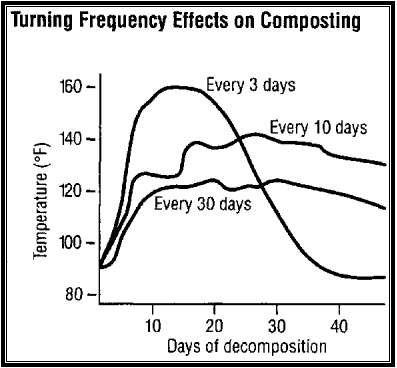AerationAerobic organisms need to breathe air to survive. Aeration is necessary in high temperature aerobic composting for rapid odor-free decomposition. Aeration is also useful in reducing high initial moisture content in composting materials. Several different aeration techniques can be used. Turning material is the most common method of aeration when composting is done in stacks. Hand turning of the compost piles or in units is most commonly used for small garden operations. Mechanical turning or static piles with a forced air system are most economical in large municipal or commercial operations. The most important consideration in turning compost, apart from aeration, is to ensure that material on the outside of the pile of units is turned into the center where it will be subject to high temperatures. In hand turning with forks, this can be easily accomplished. For piles or windrows on top of the ground, material from the outer layers can be placed on the inside of the new pile. For static piles with a forced air system, finished compost or a physical “cover” can be placed on the composting material, ensuring it reaches high temperatures uniformly. Volume reduces during the compost process. Piles or windrows can eventually be combined when turned, particularly if long composting periods are used. Frequencies of turning or total number of turns are governed primarily by moisture content and type of material. Moisture is the most important. High moisture content reduces the pore space available for air as well as reducing the structural strength of the material. This permits greater compaction and less interstitial or void space for air in the pile. Materials with a high C:N ratio may not have to be aerated as often as material which decomposes more actively and rapidly.
Studies at the University of California indicated that turning at fairly frequent intervals during the first 10 to 15 days of composting achieved approximately the same degree of stabilization as making the same number of turns over a longer period. Greater aeration during the initial stages of decomposition intensifies the activity of the microorganisms, shortens the period of active decomposition, and, consequently, reduces time and land area needed for composting. Air availability is a function not only of turning frequency but also moisture content and structure of the material. Air requirement for the biological activity depends on the availability of nutrients in the feedstocks (e.g., a very high C:N ratio material would not support as large a biological population). Thus, it is impossible to specify a minimum frequency of turning or number of turns for a variety of different conditions. Studies on composting of mixed refuse, (lawn and tree trimmings, and considerable quantities of paper and combustible rubbish) at the University of California indicated that the following schedule of turning is adequate to permit rapid decomposition. If the initial moisture content is below 70%, the first turn should be made about the 3rd day. Thereafter, turn approximately as follows until the 10th or 12th day:
If material initially contains much more than 70% moisture, it should be turned every day until the moisture content is reduced to less than 70%. The above schedule should then be followed. This turning schedule will permit rapid decomposition at thermophilic temperatures. Fewer turns would not produce as rapid composting but might be sufficient to prevent serious anaerobic conditions and odor. When compost is stored before using, moving it into a stack can sometimes serve as the last turn. It should be noted that, while the above schedule was desirable for mixed refuse, less frequent turning might have been satisfactory under other conditions. Experienced operators can estimate turning and water needs. If foul odors of anaerobic and putrefactive conditions exist when the pile is disturbed either by turning or by digging into it for inspection purposes, turn the pile daily until odors disappear. No matter how anaerobic a pile may become, it will recover under a schedule of daily turning that reduces moisture and provides aeration. Sometimes daily turning is necessary to controlling fly breeding. A temperature drop during the first 7 or 10 days of composting is a good indication that turning for aeration is necessary. Daily turning inhibits development of fungi and actinomycetes. In piles turned daily these organisms only develop sporadically, whereas in piles allowed to remain undisturbed for 2 or 3 days, they form a thick continuous layer, which reaches a maximum thickness in about 4 days. Some prefer to manage a hot or thermophilic pile for several weeks, then stop turning the pile letting mesophilic organisms take over, which encourages fungi and actinomycetes development. Fungi and actinomycetes are the best decomposers of woody matter, such as sawdust or branches. Actinomycetes gives compost the earthy smell—like that of the forest floor. In summary, avoiding anaerobic conditions, maintaining high temperatures, and controlling flies are the important criteria for degree of aeration. |
